Gravity Analysis for Location Assessment
How attractive are existing or planned locations?
The distance and attractiveness of a location have an impact on where the customer shops. A gravity analysis takes into account the individually defined attractiveness factors, which are important for the customer decision to shop at the location, and thus enables a professional location assessment.
How attractive are your locations?
With the support of gravity analysis, a professional location assessment can be prepared. You can forecast how many customers will visit a location and what potential sales can be expected. The quality of the sales forecast can thus be significantly improved.
A Gravity Analysis Provides Answers to These Questions
- How attractive is a location for customers?
- How is the local competition?
- How high is the likelihood of interaction at a location, i.e. how likely is it that customers will choose to visit a location?
- How much revenue can I expect if I open a new location here?
- How many customers with which purchasing power will visit the location?
- How will customer behavior change when new locations are opened or existing ones are closed?
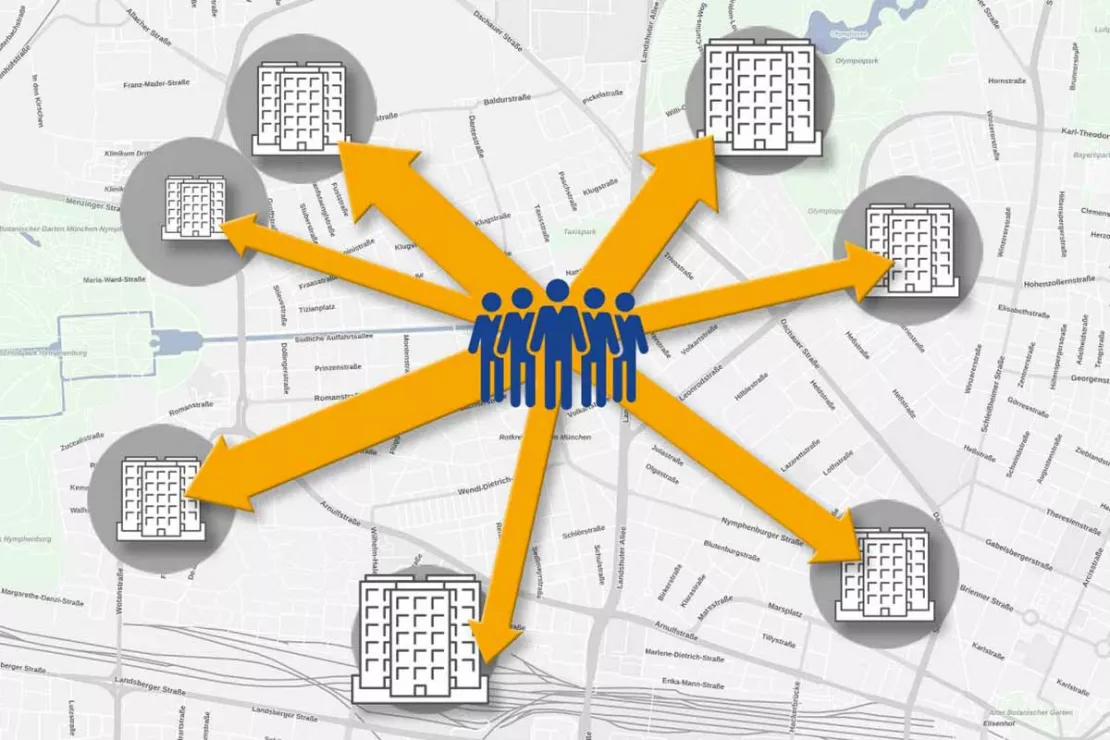
How does a gravity analysis work?
The most important factors for the location assessment are the distance between the customer and the location and the attractiveness of the location. Imagine, for example, that your customer wants to buy fresh rolls for breakfast and has three bakeries nearby. Their choice will depend on how far away and how attractive the bakeries are.
The faster and easier they can reach the bakery, the more likely they will decide to shop there. Suppose there is a bakery right next door, the second is a five-minute walk away and the third is a ten-minute bike ride away. Yet, if the bakery that is further away is more attractive, it is more likely that they will travel the extra distance to shop there.
The attractiveness of a bakery can be, for example, the quality and freshness of the baked goods, or whether the location also sells butter, milk or organic products. That is why every factor that a customer considers when choosing a location is included in a gravity analysis. The result, for example, is how much sales a branch location can expect.
We would be happy to show you what gravity analysis can do
What makes a location attractive?
As a rule, several attractiveness parameters are included in a gravity analysis. In general, the attractiveness of the location is defined by hard factors such as the sales area, accessibility, the breadth and depth of the product range and the number of parking spaces as well as soft factors such as the ambience, the friendliness of the employees and marketing activity. Both internal and external data can be incorporated, for example the size of your own branch locations, the product range and sales, as well as the corresponding data from competitors.
The WIGeoGIS team will be happy to consult you on which factors should best be incorporated into your gravity analysis. We will also perform this method of location analysis for you. Or you can learn here how to do a gravity analysis on your own with QGIS or WebGIS.
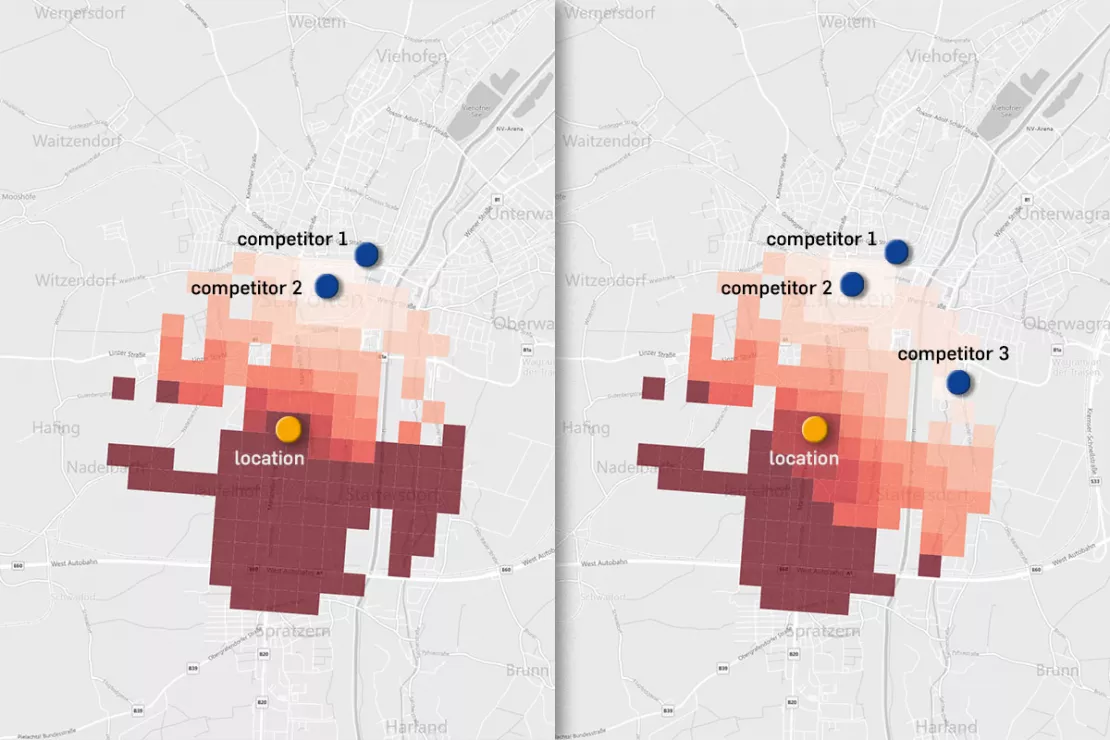
The left image shows the probability that the sales potential of this region can be bound to the location. The darker the area, the higher the potential absorption. The right image shows the probable potential absorption of the location if an additional competitor opens a new location. The attractiveness of the location in the north-east is reduced by the new competitor. The sales potential of this region will be bound to the new location.
The Strengths of Gravity Analysis in location assessment
- Flexible model for the representation of probable customer flows, taking the competition into consideration in the location analysis
- By simulating new branch locations or the closure of current branch locations (actual vs. target state), the consequences can be objectively analyzed and quantified.
- The location assessment focuses on the perspective of the customer decision.
- Can be fully automated in QGIS and WebGIS
This is how the gravity analysis works for your location assessment
Applications for Gravity Analysis
Basically, gravity analysis is suitable for industries with a large proportion of brick and mortar retail. But what about online retail, which can also have a negative impact on the business of a branch location? These numbers can be incorporated in the gravity model. If you know, for example, that 30 percent of the sales in the book market go to online retail, the total sales potential of the branch locations falls by that same 30 percent. Gravity analysis can be used to determine the potential share of this reduced total sales for your branch locations.
Classic areas of application for gravity analysis are:
- Grocery retail
- Pharmacies
- Lottery sales outlets
- Branch marketing
- Sales controlling
- Public requirement planning in health care or in church administration
Gravity Analysis in Retail Research
Large masses have a strong attraction, small masses have a weak attraction.
This principle of gravity is known from physics. This idea is also the basis of the gravity analysis for location assessment. In the 1960s, retail research subsequently began applying this principle for their needs. David L. Huff developed a mathematical model to delineate the market areas of shopping centers or retail establishments.
This formula, the Huff model, is also the basis for gravity analyses. The formula allows you to calculate the probability that customers will travel from their home or work to go shopping at a certain location. When using gravity analysis for location assessment, the principle of gravity can be adapted as follows:
Large, attractive locations attract many customers, while small, unattractive locations attract fewer customers.
You can find out more about the Gravity Analysis Software and other methods of location assessment here
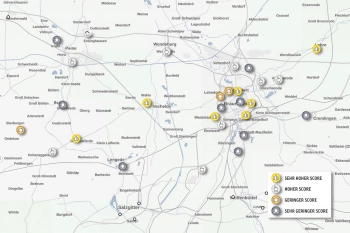
Scoring Model for Location Analyses
Scoring analyses are ideal for evaluating locations quickly and clearly. They are also perfect for comparing multiple locations at once.
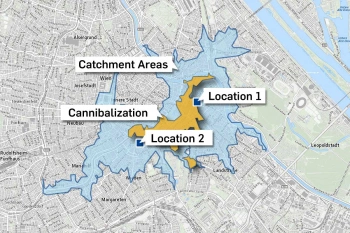
Calculate Cannibalization Rate Using Overlay Analysis in QGIS
QGIS plugin makes the cannibalization of two or more locations visible and shows how much business they are taking away from each other.
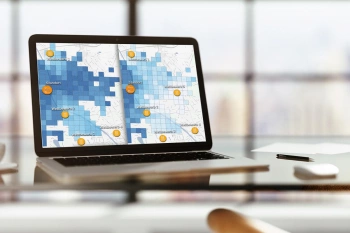
Gravity Analysis Software
Do you need a location assessment for stores but you have no expertise in GIS systems? Reliable sales forecasts are also possible without expert knowledge
Gravity Analysis: Request a FREE Live Demo!
- FREE Live-Demo* of gravity analysis
- Non-binding, without further obligations
- Online presentation via video call
Do you want to know more about location assessment using gravity analysis? I will be glad to support you.
FAQ
-
Can the gravity model be verified?
Yes. As a rule, new branches and locations do not emerge on the greenfield, but there are already empirical values from existing locations. Follow these steps to calibrate the gravity model to reality: First, prepare a sales forecast for the new location. Second, prepare a sales forecast for existing branch locations. If you find that the result deviates from reality and for example a branch location has only 16 million euros in sales, while the forecast is for 18 million, then adjust one or the other parameter in the gravity model until the result of the forecast corresponds to the actual sales of the existing branch location. This calibration brings the model closer to reality and makes the location assessment more accurate.
-
Which criteria are relevant for attractiveness and how is the weighting done?
Often the sales area and the age of a location form the basic data for the gravity model. This data serves as the basis for various attractiveness parameters such as the breadth and depth of the product range, the parking space situation and opening hours. Environment variables can also play a role, such as: Are there footfall generators in the vicinity that also bring customers to your location? Is there a train station nearby? Is the location in a commercial area or a pedestrian zone? In general, the attractiveness parameters and their weighting are a very broad field and must be defined individually for the location assessment.
-
What are the limits of a gravity model?
Of course, a computer-based model like gravity analysis can only ever describe part of the real world. However, the more data that is available, the more accurately the gravity model can predict the future. One difficulty is often that you do not have enough data from your competitors: You know how many branch locations competitors have in the vicinity and possibly also how big they are, but you rarely know the sales figures of these branch locations. Also, the softer the factors, the more difficult it becomes: How can soft skills such as employee friendliness or the quality of advice be quantified? Allowing this data to flow into the gravity model would only be possible if there was an evaluation standard that could be applied. Here too, however, it would be difficult to get comparative data from you competitors. Therefore, similar to astrophysics, the field where the ideas on gravity originated, some things that cannot be clearly explained, remain in the dark.
-
How can the gravity analysis be implemented concretely?
As a rule, we perform the gravity analysis for you in consulting projects. However, it is also possible to do this kind of location assessment yourself in QGIS or WebGIS. If this is what you prefer, we would be happy to provide consultation and support you with your own implementation.
Gravity Analysis for Location Assessment: Live demo free with no obligation

